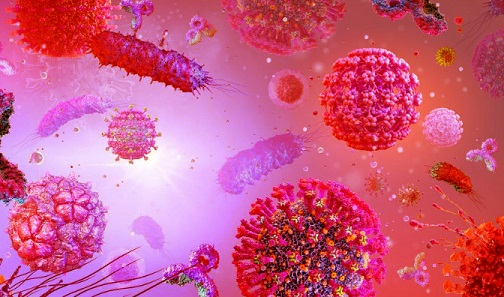Nikhil Prasad Fact checked by:Thailand Medical News Team Dec 20, 2024 3 months, 3 weeks, 3 days, 7 hours, 5 minutes ago
Medical News: How the Pandemic Shaped the Viral World
The COVID-19 pandemic, which began in late 2019, was a defining moment in modern history. Beyond its devastating impact on lives and economies, the pandemic has profoundly reshaped our understanding of viruses and how they evolve. Unknown to many, the COVID-19 pandemic has also led to the evolution of other viruses and the emergence of newer strains. Research from various institutions, including Universidad Científica del Sur in Peru, Lebanese American University in Lebanon, Universidad Nacional Autónoma de México, and Universidad Autónoma de San Luis Potosí in Mexico, sheds light on these changes.
 Impact of COVID-19 on the Evolution of Other Viruses
Impact of COVID-19 on the Evolution of Other Viruses
For years, researchers have studied how human behaviors during the pandemic - lockdowns, mask-wearing, and social distancing - altered the trajectory of other respiratory viruses. This
Medical News report delves into the fascinating findings of these studies and how they offer insights into the complex interplay between human activities and viral evolution.
Suppression and Resurgence of Respiratory Viruses
A critical phenomenon observed during the initial period of the pandemic was the sharp decline in respiratory virus activity, particularly influenza and respiratory syncytial virus (RSV). Data from the Global Influenza Surveillance and Response System revealed that influenza activity plummeted between April and November 2020. This was mirrored by similar declines in RSV and other common respiratory infections. The pandemic’s global reach effectively stifled these viruses, as travel restrictions, increased hygiene measures, and reduced person-to-person contact disrupted their transmission pathways.
Interestingly, as restrictions eased, these viruses made a dramatic comeback. In Ghana, a sentinel surveillance study by Asante and colleagues showed that influenza cases were virtually nonexistent until the latter part of 2020. By late 2021, however, influenza activity resurged, albeit with unusual patterns and timing. Similarly, RSV, a virus notorious for affecting children, saw significant disruptions in its typical seasonal outbreaks.
Mutations and Viral Evolution
The prolonged suppression of these viruses gave rise to a new challenge: mutations. When viruses face reduced transmission, they often adapt to ensure their survival. Researchers documented this trend extensively in RSV. For instance, concurrent mutations in the RSV-B fusion protein were noted during the 2021-2022 season. These mutations reduced the effectiveness of nirsevimab, an antibody treatment, by up to 29.9-fold in some cases. This adaptation bears similarities to the evolution of the RSV-A ON1 genotype during the H1N1 pandemic in 2009, where a duplication in the viral genome led to the emergence of a more resilient strain.
These findings underline the dynamic nature of viruses. They do not merely disappear during pandemics; instead, they bide their time, waiting for an opportunity to reemerge stronger and more adaptabl
e.
The Role of Immune Debt
Another crucial concept explored during the pandemic is “immune debt.” When people are less exposed to common pathogens due to stringent health measures, their immunity wanes. This phenomenon has far-reaching implications. For instance, the resurgence of RSV and influenza post-pandemic was partly attributed to a population-wide decrease in immunity. This weakened defense allowed these viruses to spread more aggressively once restrictions were lifted.
Regional and Global Impacts
Studies from different regions highlighted how the pandemic’s effects varied worldwide. In Tennessee, a retrospective cohort study observed a decline in RSV cases among children under five during the pandemic years. Similarly, in Ethiopia, researchers examined the factors influencing COVID-19 severity and found that comorbidities like hypertension and diabetes played a significant role.
Globally, the pandemic has reshaped the epidemiological landscape. Co-circulation patterns of viruses have shifted, altering how these pathogens compete and interact. For instance, the atypical circulation of influenza A/H5N1 raised questions about its potential to trigger another pandemic. While no immediate threats have been identified, researchers are closely monitoring these developments.
Key Takeaways for the Future
The COVID-19 pandemic has provided invaluable lessons about viral evolution and human behavior. The suppression of respiratory viruses demonstrated the effectiveness of public health measures in controlling disease spread. However, it also revealed the unintended consequences of these measures, such as immune debt and the acceleration of viral mutations.
Moving forward, it is crucial to balance public health interventions with strategies that maintain population immunity. Enhanced surveillance systems, coupled with advanced diagnostic tools, will play a vital role in achieving this balance. Additionally, ongoing research into viral evolution will help us anticipate and respond to future outbreaks more effectively.
Conclusion
The COVID-19 pandemic has forever changed the landscape of virology. By altering human behaviors, it disrupted the transmission of many viruses, leading to significant epidemiological shifts. These changes have brought both challenges and opportunities. While we have seen the emergence of more resilient viral strains, we have also witnessed unprecedented advancements in diagnostics and therapeutics.
The lessons learned from this pandemic extend beyond COVID-19. They emphasize the need for a holistic approach to public health - one that considers the interconnectedness of viruses, human behavior, and global health systems. As researchers continue to unravel the pandemic’s impact, one thing is clear: our understanding of viruses and how they evolve will never be the same.
The study findings were published as an editorial article in the peer-reviewed journal: Frontiers in Virology.
https://www.frontiersin.org/journals/virology/articles/10.3389/fviro.2024.1527580/full
For the latest on the Evolution of Viruses, keep on logging to Thailand
Medical News.
Read Also:
https://www.thailandmedical.news/news/oblivious-to-many-the-herpes-simplex-viruses-are-recombining-and-evolving
https://www.thailandmedical.news/news/new-rsv-strain-in-china-infecting-children-with-existing-sars-cov-2-impaired-innate-immunity,-paving-the-way-for-opportunistic-mycoplasma-pneumoniae
https://www.thailandmedical.news/news/study-validates-that-it-s-a-new-strain-of-oropouche-virus-that-is-wreaking-havoc-across-brazil-and-soon-globally
https://www.thailandmedical.news/news/global-warming-is-creating-opportunities-for-deadly-strains-of-cholera
https://www.thailandmedical.news/news/rapid-spread-of-new-super-strain-bacteria-threatens-asia
